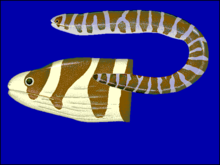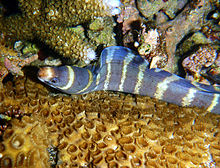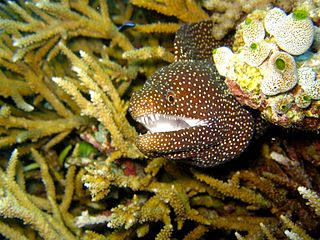
Moray eels, or Muraenidae, are a family of eels whose members are found worldwide. There are approximately 200 species in 15 genera which are almost exclusively marine, but several species are regularly seen in brackish water, and a few are found in fresh water.
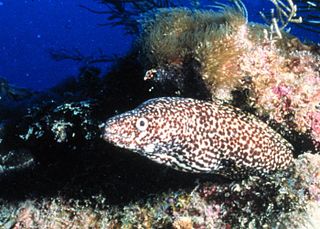
The spotted moray is a medium to large moray eel. Other common names include conger, spotted eel, red moray, speckled moray, white cong, white jawed moray, white-chinned moray and white-jawed moray eel. Spotted eels have a long snake-like body, white or pale yellow in general with small overlapping reddish brown to dark-brown spots. They are commonly 60 cm (24 in) in length and can grow up to 2 m (6.6 ft), weighing 2.51 kg (5.5 lb). They inhabit the Western Atlantic Ocean from North Carolina and Bermuda to Brazil, including the Gulf of Mexico and the Caribbean. They are also found around the Mid- and Eastern Atlantic islands as far south as St Helena. They are typically found anywhere from the surface to a depth of 200 m (660 ft).
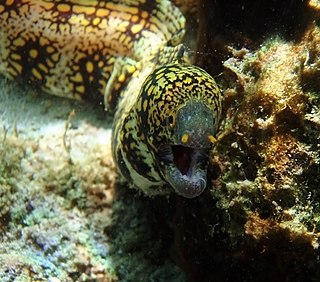
Echidna is a genus of moray eels in the family Muraenidae.

The Kidako moray is a species of marine fish in the family Muraenidae. It inhabits coral reefs or lagoons and could be found in tropical and subtropical seas near Taiwan, Japan, and Australia. The species is diurnal, which means it is more active in the daytime than the nighttime. It is also piscivorous: it consumes fish, octopus, and squid. Other than the Kidako moray, there are about 200 species of moray eels in the Muraenidae family. The Kidako moray would not attack humans unless they are provoked. However, due to the menacing looks of the Kidako moray and moray eels in general, they are feared by divers and snorkelers.

The zebra moray is a species of marine fish in the family Muraenidae. It is the only member of the genus Gymnomuraena, though it sometimes has been included in Echidna instead.
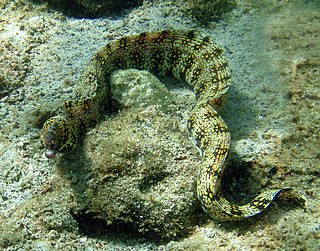
The snowflake moray, also known as the clouded moray among many vernacular names, is a species of marine eel of the family Muraenidae. It has blunt teeth ideal for its diet of crustaceans, a trait it shares with the zebra moray.

The fimbriated moray, also known as dark-spotted moray or spot-face moray, is a moray eel of the family Muraenidae.

The giant moray is a species of moray eel and a species of marine fish in the family Muraenidae. In terms of body mass, it is the largest moray eel; however, the slender giant moray is the largest in terms of body length.

Echidna catenata, commonly known as the chain moray, is a moray eel found in shallow parts of the western Atlantic Ocean and from islands elsewhere in the Atlantic. It occasionally makes its way into the aquarium trade. It grows to a maximum length of 165 cm (65 in) but a more common length is about 40 cm (16 in).

Acanthurus polyzona, commonly known as the black-barred surgeonfish or zebra tang, is a tropical fish found in coral reefs in the western Indian Ocean. It was first described in 1868 by the Dutch ichthyologist Pieter Bleeker, who gave it the name Rhombotides polyzona; it was later transferred to the genus Acanthurus, becoming Acanthurus polyzona.
Scuticaria okinawae is a moray eel found in the Pacific and Indian Oceans. It is commonly known as the shorttailed snake moray, shorttail moray, Seale's moray eel, or the Bennett's moray.

Scuticaria tigrina is a moray eel found in coral reefs in the Pacific and Indian Oceans. It is commonly known as the tiger reef-eel, tiger snake moray, tiger moray eel, tiger moray, tiger eel, spotted eel, or the spotted snake moray.
Channomuraena vittata is a rare species of moray eel from the Anguiliformes order found in reefs. It is commonly known as the broadbanded moray, banded moray, Chinese moray, double-ended moray, or the long-jawed moray.

Echidna amblyodon, the Sulawesi moray is a moray eel found in the western central Pacific Ocean. It was described by Bleeker in 1856, originally under the genus Muraena. It is a marine, tropical eel which is known from Indonesia, in the western central Pacific Ocean. Males can reach a maximum total length of 20.5 centimetres (8.1 in).
Echidna leucotaenia, the whiteface moray, also known as the white-banded moray eel, is a moray eel. It was described by Schultz in 1943. It is a tropical, marine and freshwater eel which is known from the Indo-Pacific, including East Africa, the Line Islands, the Tuamotu Islands, and Johnston Island. It dwells at a depth range of 0 to 24 metres, and leads a benthic lifestyle in reefs. Males can reach a maximum total length of 75 centimetres (30 in).

Echidna nocturna is a moray eel found in the eastern Pacific Ocean, in the Gulf of California and around Peru and the Galapagos Islands. It was first named by Cope in 1872, and is commonly known as the freckled moray or the palenose moray. It was discovered that Echidna nocturna and Muraena acutis are the same species.
Echidna unicolor is a moray eel found in coral reefs in the Pacific and Indian Oceans. It was first named by Schultz in 1953, and is commonly known as the unicolor moray or the pale moray. It is usually completely tan or light brown in color, aside from a dark ring around each eye.

The lipspot moray eel, also known as the textile moray, white-lipped moray or white-lipped reef eel, is a moray eel found in coral reefs in the Pacific and Indian Oceans. It was first named by Pieter Bleeker in 1864.

Gymnothorax rueppelliae, the banded moray, banded reef-eel, Rüppell's moray, Rüppell's moray eel, black barred eel, yellow-headed moray eel or yellow-headed moray, is a moray eel found in tropical coral reefs. Gymnothorax rueppelliae is a pale grey to greyish-brown moray with 16-21 dark bars on the body, a bright yellow head and a dark spot at the corner of the mouth. They differ from the Gymnothorax pikei, a close relative that lives Papua New Guinea. They have fewer vomerine teeth. They also reach a maximum length of 80 cm.

The zebra garden eel, also known as the banded garden eel, is a species of eel in the conger/garden eels family Congridae. It was described by Pieter Bleeker in 1868. It is a marine, tropical eel which is known from the Indo-Western Pacific, including the Philippines, the Ryukyu Islands, New Guinea, Indonesia and Vanuatu. It inhabits shallow waters at a depth range of 1 to 10 m, and forms burrows in colonies of moderate size on sand sediments in bays, slopes and reefs. Males can reach a maximum total length of 34.7 cm.
